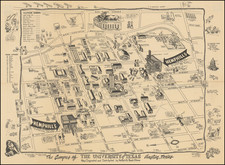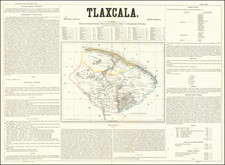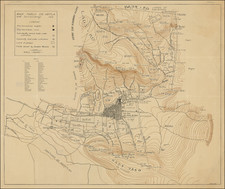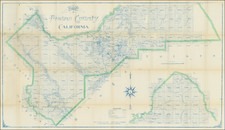Spanish Manuscript Map of Spanish Texas, Louisiana Territory and the Transmississippi West
Recently discovered second surviving example of Jose Antonio Pichardo's manuscript map of Texas, Louisiana Territory and the Transmississippi West, prepared specifically for use by the Spanish Crown in defending its claims to Spanish Texas against the United States' post-Louisiana Purchase Jeffersonian claims that the U.S. had purchased from France ownership of all the lands between the Mississippi River and the Rio Grande.
Pichardo's map is the visual embodiment of 250 years of historical evidence supporting Spain's claim to Texas and the lands east of the Rio Grande, following the Jeffersonian claims to ownership of Texas as part of the Louisiana Purchase. Over the next two decades, Pichardo's remarkable compilation would play a central role in shaping and defining both the Adams Onis Treaty of 1819 and the subsequent report of Mexican Boundary Commissioner, General Manuel de Mier y Teran, when he surveyed Texas in 1827 and 1828, which set in motion the chain of events which gave rise to the first Texan revolts, leading to Texan Independence in 1836.
Prepared as a response to American claims that the Louisiana Purchase included all of the lands between the Mississippi River and the Rio Grande, Pichardo's large map was the visual foundation for a 5,000 page report prepared by for the Spanish Crown in 1811, setting forth Spain's historical claims to ownership of Texas and contiguous regions. Pichardo's work would become the primary source document for Spanish negotiations which led to the Adams-Onis Treaty and later used by Mier & Teran in the boundary commission expedition of 1827-1828, following Mexico's independence from Spain.
Put simply, the Pichardo map represents the visual embodiment of Spanish Texas and the Transmississippi Wesat on the eve of its opening as a viable frontier for American and European settlement. Virtually unknown to scholars and historians until its "rediscovery" by Professor Bolton in the early 20th Century, Pichardo's map compiles in a single visual graphic the sum total of Spain's claims to Texas dating back to the 16th Century.
Overview of The Map
Over a period of four years, Pichardo created a massiven argumentative historical treatise, intended to survey and and describe "the true limits of the provinces of Louisiana and Texas." Written by Father Jose Antonio Pichardo (1748-1812), of the congregation of the Oratory of San Felipe Neri, the purpose of the Treatise was to respond to and to disprove the claim of the United States that Texas was included in the Louisiana purchase of 1803. As a means of combining his work into a single visual graphic, Pichardo created a large manuscript map which compiled information from the other maps referenced and illustrated in Pichardo's Treatise.
Pichardo's map extends from the southernmost tip of Vancouver and the Straits of Juan De Fuca in the Pacific Northwest, to the mouth of the Rio Bravo and Rio de la Nueces Rivers on the southernmost Texas Coastline, the Mississippi Delta, following the Mississippi River north to its then known headwaters to the east of "Lac des Bois" (the Lake of the Woods, in present day Manitoba), embodying in a single document the region which would become known as the "Transmississippi West."
As a compilation, Pichardo's map is unique in its preservation of the language employed by its source materials. While internally it is drawn largely from the cache of secret Spanish maps available to Pichardo in Mexico City, Madrid and elsewhere, Pichardo also incorporates (and transcribes on the map in the original text languag) English language sources for the Upper Mississippi River Region and French language sources for the information regarding the the Missouri River Valley and its tributaries.
Overlaid on Pichardo's map quite prominently is information derived from the maps produced by Don Bernardo Miera y Pacheco following the conclusion of the Dominguez-Escalante Expedition of 1776. These maps have been described by H.S. Aurback in is work on Father Escalante's Journal as showing "the earliest cartographical representation of Utah, Colorado and the adjoining regions."
Along the Northwest Coast, Pichardo relies heavily on information originally drawn from the Malaspina Expedition, commissioned in 1790, to explore the Northwest Coast of America in defense of Spanish claims to the region, as well as information derived from late 18th Century cartographic sources created by Anza and Costanzo in California and New Mexico.
In Texas, Pichardo draws heavily upon the cartographic productions of Father Francisco Puellas, who from 1803 onwards had been based in Nacogdoches and had produced a number of maps of Texas and its sub-regions both for Anglo agents, such as Thomas Power and Juan Bautista Elguezabal, the Spanish Governor of Texas.
Overlaid on Pichardo's compilation of geographical and topographical sources, Pichardo incorporates both historical information and the details of the most important roads through the region, utilizing a color coded depiction of the various primary Spanish expeditionary routes, including the routes of Coronado and Juan Dominguez de Mendoza (leader of the 1680-81 suppression of the Pueblo revolt, which re-asserted Spain's hold over Spanish Texas).
Lastly, Pichardo boldly delineates the proposed lines of demarcation for the boundary between the United States and Spanish Texas, as set forth by various contemporary Spanish authorities. Specifically denoted are:
- Francisco Puellas's proposed boundary
- Don Angel de Martos Navarete's proposed boundary (Governor of Texas, 1759 to 1767).
- Fray Melchior Talamantes' (Pichardo's predecessor) proposed boundary
- Pichardo's own proposed boundary
Pichardo's grand image presents a comprehensive overview of Spain's vision of the Transmississippi West and the template upon which Pichardo laid out the conclusions of his 5,000 page historical treatise regarding Spain's historical (and ultimately successful) claims to Texas.
The Pichardo Treatise, and its resulting diplomatic successes in establishing the primacy of Spain's claims to Texas, became the starting point for the modern history of Texas, its initial settlement and independence.Had Pichardo's work proven less successful, the modern history of Texas would unquestionably have taken a different course, Jeffersonian interests would have resulted in a clear path to American settlement in the region, and the rich history of Texas, its Independence, French and German colonies and many of its other defining historical features would never have come to pass.
Historical Overview
In 1803 the United States acquired Louisiana from Napoleon Bonaparte, with the understanding that the purchase covered all territory ceded by France to Spain in 1762 and then back to France in 1800. France, by failing to specify the historic boundary in the sales agreement, placed the burden of proof on Spain. As the line between France and Spain in the New World had never been clearly established, Thomas Jefferson's administration seized the opportunity to make the most of its claim to a vast, uninhibited, and largely unexplored land. Soon after the United States flag went up in the Place d'Armes in New Orleans on December 20, 1803, Americans began to scurry about the frontier at Jefferson's direction. Their purpose was to gather information, conduct explorations, and make maps.
Jefferson's vision is clearly reflected in the exploratory expeditions commissioned in the years immediately following the Louisiana Purchase. Within a few years of the purchase, Jefferson had authorized 4 expeditions to explore the newly acquired Territory. While the Lewis & Clark Expedition focused on the Northwestern portions the United States, the remaining 3 expeditions, The Dunbar Expedition (1804-1805), the Pike Expedition (1806-1807), and Red River (or Freeman-Custis) Expedition (1806) were all focused on lands that were the subject of competing Spanish claims, provoking diplomatic incidents as a result of American incursions into the disputed territory.
While Jefferson's agents were busy testing the elastic boundaries of the Purchase, the Spaniards were not idle. Wary of their new neighbor and fearful for their vulnerable possessions in Texas and New Mexico, Spanish officials in New Orleans and beyond hastened to establish their line of demarcation. Boundaries had to be defined, a multitude of jurisdictional problems resolved, and the Americans kept out of land that France had never owned-Spanish lands. Imagine, then, the anxiety stirred in December of 1803, when the French Prefect of Louisiana, Pierre Clement de Laussat, declared that the western boundary of the Louisiana Purchase lay at the Rio Grande.
In 1806, a military agreement was entered into between General James Wilkinson of the United States Army and General Simon Herrera of the Spanish forces, making the country between the Arroyo Hondo and the Sabine River temporarily neutral ground, over which neither the United States nor Spain should exercise political jurisdiction. The agreement was generally observed by both countries; the United States took possession of territory as far west as Natchitoches, while Spain maintained a small garrison at its eastern outpost, Nacogdoches.
President Jefferson was convinced as early as 1804 that the territory included in the Louisiana Purchase extended to the Rio Grande. His insistence upon this and his efforts to promote the exploration of the western territory (to some of which Spain claimed unquestionable right), and the border dispute in the Sabine-Red River region, temporarily settled by the Wilkinson-Herrera agreement, brought the United States and Spain near to hostilities. As such, Spain was stimulated to adopt defensive measures to safeguard her frontier. Both sides exhibited old maps and cited historical authorities to support their contentions, setting the stage for a legal battle of historical claims to the region.
Spain Forms An Historical Commission To Define Its Claims To Texas etc.
Following a royal order issued in May 1805, Jose de Iturrigaray, the viceroy of New Spain, in January 1806, named Fray Melchior de Talamantes chief of an historical commission created to ascertain from all available sources the true boundaries of the provinces of Texas and Louisiana, before the latter was ceded to Spain in 1762. However, the arrest and deposition of Iturrigaray and the subsequent arrest of Talamantes for his separatist views by the Audiencia of Mexico in September, 1808, interrupted the work of this commission. The following month, the Viceroy ad interim, Pedro de Garibay, appointed Fray Doctor Jose Antonio Pichardo to determine the historic limits of Louisiana and Texas. The results of Pichardo's findings constitute a monumental work of prime importance to the Texas-Louisiana region.
Over the next four years, Pichardo worked tirelessly to compile a monumental defense of Spain's traditional Louisiana boundary with France. Pichardo gathered maps far and wide to support his idea of where the historic line had been. In his treatise, he included a series of these maps, designated as Document 74. His original intention was to submit "exact copies" of fourteen maps that he thought proved what had once been the boundary between French and Spanish Possessions, and, after cession of 1762, between neighboring provinces of the Spanish Crown. Having assembled and copied these fourteen maps, he later added a few more to further strengthen his geographic assertions.
Father Pichardo then created an elaborate new map, using only the most trustworthy sources--primarily the maps of Jean Baptiste Bourguignon d'Anville, a celebrated French geographer whom he regarded very highly, which he augmented with manuscript maps in the Spanish archives which had never before been published or compiled into a single comprehensive regional template. It was this composite map that he offered to the King as the final word on the boundary question (designated by his no 19). . . .
Pichardo's treatise was constructed as an argumentative historical treatise, intended to survey and describe "the true limits of the provinces of Louisiana and Texas." Written by Father Jose Antonio Pichardo (1748-1812), of the congregation of the Oratory of San Felipe Neri, the purpose of the Treatise was to respond to and to disprove the claim of the United States that Texas was included in the Louisiana Purchase of 1803. Pichardo also found it necessary to describe and refute the prior boundary descriptions set forth by his predecessor, Talamantes, as well as the writings of former Texas Governor Navarette and even the work of his contemporary, Francisco Puellas, who had between 1803 and 1808 created a number of new manuscript maps of the region.
Pichardo's Treatise is without question the most comprehensive report on the exploration, geography and mapping of Spanish North America, providing by far the most detailed study of the history of Texas and contiguous regions ever compiled in writing, often utilizing original Spanish manuscript maps and other sources, some of which would soon be disbursed or lost in the transition period of Mexico's fight for independence, which had already commenced with the Grito de Dolores in September 1810 and which would plunge Mexico into an 11 year civil struggle, concluding with its independence in September 1821.
Neither Pichardo's treatise, his large compilation map nor the maps copied for this Treatise saw publication or wide circulation during the nineteenth century. By the time that Herbert E. Bolton rediscovered the Pichardo Treatise in the archives of Mexico, the maps in Document 74 had long since become scattered and presumed lost.
The diplomatic importance of the Pichardo Treatise and map is highlighted in a series of correspondence between Spanish Viceroy Felix Calleja in Mexico City and the Spanish Secretary of State between 1813 and 1817, which concluded with Calleja's transmission of a complete copy of Pichardo's original 5000 page Treatise to Madrid over the course of several years, concluding in September 30, 1816. The correspondence includes a reference to the copying of Pichardo's maps by "Don Gonzalo Lopez de Haro, teniente de navio y ayudante de director de pilotos del department de Cadiz, the only person qualified for the task." Lopez de Haro, credited as the first European to discover the San Juan Islands in the Pacific Northwest, had been a "primer piloto" in the Malaspina expedition and Spain's most competent map maker in the New World. While a definitive handwriting study has not been conducted, the present example of the Pichardo's map is most likely in his hand, having been hastily (and somewhat incompletely) copied for use by the Spanish Secretary of State, but as noted in greater detail below, actually incorporating in several regions far more accurate and detailed topographical details in key areas of Louisiana.
Once received, Pichardo's material was transferred to the Spanish State Department. The material came into the hands of the Spanish undersecretary and head of the Spanish Embassy in the United States, Narciso de Heredia, who was the primary official in Madrid charged with transmitting instructions to Don Luis de Onis during the negotiations of the Adams Onis Treaty. Three weeks after receipt of the Pichardo Treatise, Heredia produced for De Onis his single greatest charging document, a long exposition on the issues in controversy with the United States, in which he prominently includes material from Pichardo's report.
Later, in the Summer of 1818, a messenger would be dispatched by Heredia to De Onis, with actual extracts of material drawn from Pichardo's report. With this material in hand and armed with the knowledge of troves of additional documentary evidence in Madrid, De Onis would meet with Adams in October 1818, which discussions led to the conclusion of the Adams Onis Treaty in February 1819.
The Pichardo Treatise and Its Subsequent Role in Texas History
The Adams-Onis Treaty of 1819 resolved the land ownership dispute by conceding the validity of Spain's Claims to Texas and the lands east of the Rio Grande, in exchange for Spain's abandonment of its historical claims to Oregon and Florida.
While the original Pichardo manuscript was written prior to the Adams Onis Treaty, it was not translated and published for more than 100 years, when the original manuscript in the Mexican archives was translated into English by Charles Wilson Hackett, Charmion Clair Shelby, and Mary Ruth Splawn, M. A., and edited and annotated by Charles Wilson Hackett for the University of Texas Press, between 1931 and 1946, including the creation of a photo facsimile of the map offered here.
Following Mexican Independence in 1821, the issue resolving the boundary languished and the time for appointing boundary commissioners passed. At the time Joel R. Poinsett was appointed minister from the United States to Mexico in 1825, nothing had been done to settle the boundary, and on July 1825, Poinsett held his first conference with Lucas Alaman on the question. Poinsett suggested that although the United States had held itself bound to carry into effect the treaty of limits is concluded with Spain, still it would appear more becoming to the independent character of the government of Mexico if it lay aside that treaty altogether, and endeavor to establish a boundary which might be more easily defined and mutually more advantageous. Conferences between Poinsett and Alaman continued in October 1825 with no progress. At least one historian has written that within a few months, it became clear that both sides were "really wishing to secure the extreme limits claimed on the one side by the United States and by Spain on the other before the Treaty was concluded. Each had also discovered that the other was determined not to give up anything which that treaty had secured to it.
Mexico would finally send a qualified official into the field in 1827, for the purpose of attempting to establish the boundary with finality. General Manuel de Mier y Teran, was charged in 1827 with an expedition to investigate Texas and confirm the limits defined in the Adams Onis Treaty. Mier y Teran physically had possession of the entire Pichardo Treatise during his expedition to Texas in 1827 and 1828.
General Terán first came Texas as the head of the Comision de Limites. The expedition included artist Jean-Luis Berlandier and cartographer Jose Maria Sanchez y Tapia. Sent by the President of Mexico, Guadalupe Victoria, the principal purpose of the expedition was to demarcate the United States border established by the Adams Onis Treaty of 1819 between the Sabine and Red Rivers. In addition, General Terán was tasked with reporting on the natural resources of the province, the condition of its Indians, and the number and disposition of any American or French settlers.
Mier y Teran surveyed the region in 1827 and 1828, and in January 1829, reported to Mexico City that unless the Mexican government took timely measures, the Texas settlers were certain to rebel. Differences in language and culture, Teran believed, had produced bitter enmity between the American colonists and native Mexicans. The colonists refused to learn the Spanish language, maintained their own separate schools, and conducted most of their trade with the United States.
To reassert its authority over Texas, the Mexican government reaffirmed its constitutional prohibition of slavery, established a chain of military posts, levied customs duties, restricted trade with the United States, and decreed an end to further immigration from the United States. These actions might have provoked a revolt in Texas, but in 1832, General Antonio López de Santa Anna became Mexico's president. Many colonists hoped that he would make Texas a self-governing state within the Mexican republic. Once in power, however, Santa Anna proved far less adaptable than many had hoped. In 1834, he overthrew Mexico's constitutional government and made himself dictator.
In November 1835, Anglo-American colonists adopted a constitution and organized a temporary government but voted overwhelmingly against independence. A majority of settlers hoped to attract the support of Mexican liberals in a joint effort to depose Santa Anna and restore power to the state governments, including a separate state of Texas.
While holding out the possibility of compromise, the Texans prepared for war. The provisional government elected Sam Houston, a former Tennessee governor, to lead whatever forces he could muster. Then in early 1836, a band of three hundred to five hundred Texans captured Mexico's military headquarters in San Antonio. The Texas revolution was under way.
Soon the ominous news reached Texas that Santa Anna himself was marching north with seven thousand soldiers to crush the revolt. In actuality, Santa Anna's army was not particularly impressive; it was filled with raw recruits and included many Maya Indians who spoke and understood little Spanish. When Houston learned that Santa Anna's initial goal was to recapture San Antonio, he ordered the city abandoned. But Texas rebels decided to defend the town and made their stand at an abandoned mission, the Alamo.
Notes Regarding The Present Map
The Pichardo manuscript map in the Mexican Archives has no detail at all along the barrier islands on the Gulf Coast and the Lower Mississippi Delta. The newly discovered manuscript map offered here has 1 additional place name along the Texas Coast, Bancos de Has (Hos?) to the west of Pta del Fierro, and includes a far more sophisticated topographical depiction of this region.
In the Mississippi Bayou region, in the general area of Baton Rouge, there appear to be several additional place names. Curiously, the placement of Manchak is across the river from something shown on our map as San Gabriel. Fort San Gabriel de Manchak was an important early Spanish fort in this region. There is also the additional place name "juan".
Conclusion
Pichardo's map is one of the fundamental Western Americana maps of the 19th Century. Its important lies in both its synthesis and summation of the best available Sanish information on the Mapping of the entire Transmississippi West immediately following the Louisiana Purchase and, perhaps more importantly, as the primary "risk assessment" document utilized by Spain in negotiating the Adams-Onis Treaty.
On this latter point, while scholars have noted that Spain did not ultimately attempt to negotiate any one of the 4 prospective boundaries set forth by Pichardo, the real historical value of the Pichardo map, in the context of the Adams-Onis Treaty negotiations, was that in may respects, it was the visual summary of what the Spanish knew they could and could not prove in the process of negotiating the Treaty--a perspective unknown to the Americans (and to scholars for the next 100 years).
In all respects, Pichardo's map is without question one of the most important maps of the Transmississippi West.











![[ Sonoma County ] Map of Sonoma County California Showing New Boundary Lines of County and Townships, Private Claims and Ranches, Government Townships and Section Lines, Rail Roads and Public Roads Water Works Cities Towns School Districts, etc. Carefully Compiled From The Latest Authorities By R.A. Thompson, County Clerk . . . 1884](https://storage.googleapis.com/raremaps/img/small/99877.jpg)


![(Aztec Tribute List) [Original watercolor showing tribute items paid to the Aztecs by subject towns] Mendoza Col. part 1s Lorenzana, Aglio 1, Vol 22...](https://storage.googleapis.com/raremaps/img/small/102321.jpg)